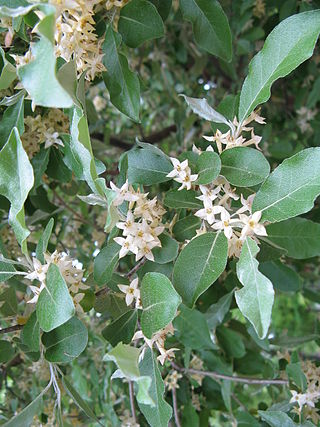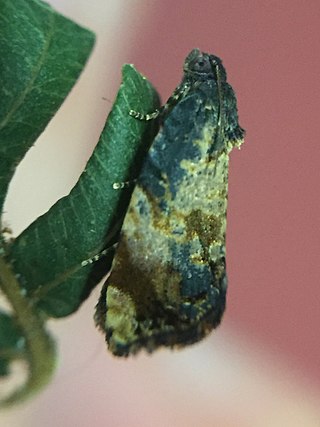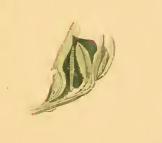
The Elaeagnaceae are a plant family, the oleaster family, of the order Rosales comprising small trees and shrubs, native to temperate regions of the Northern Hemisphere, south into tropical Asia and Australia. The family has about 60 species in three genera.

Elaeagnus umbellata is known as Japanese silverberry, umbellata oleaster, autumn olive, autumn elaeagnus, spreading oleaster, autumnberry, or autumn berry. The species is indigenous to eastern Asia and ranges from the Himalayas eastwards to Japan. It is a hardy, aggressive invasive species able to readily colonize barren land, becoming a troublesome plant in the central and northeastern United States and Europe.

Elaeagnus angustifolia, commonly called Russian olive, silver berry, oleaster, or wild olive, is a species of Elaeagnus, native to Asia and limited areas of eastern Europe. It is widely established in North America as an introduced species.

Elaeagnus is a genus of about 50–70 species of flowering plants in the family Elaeagnaceae. Species of the genus are commonly known as silverberry or oleaster,

Hyles hippophaes, the seathorn hawk-moth, is a species of moth in the family Sphingidae. The species was first described by Eugenius Johann Christoph Esper in 1789.

Apatetris is a genus of moths in the family Gelechiidae.

Monochroa is a genus of moths in the family Gelechiidae.

Cryphia ochsi is a moth of the family Noctuidae. It is found in the Central and Eastern part of the Mediterranean Basin. In the Levant it has been recorded from Lebanon and Israel.

Redectis vitrea, the scalloped snout or white-spotted redectis, is a litter moth of the family Erebidae. The species was first described by Augustus Radcliffe Grote in 1878. It is found in the United States from Illinois to south-eastern Massachusetts, south to Texas and Florida.

Philocryptica is a monotypic genus of moths belonging to the subfamily Tortricinae of the family Tortricidae. It contains only one species, Philocryptica polypodii, the leather-leaf star-miner, which is endemic to New Zealand. This species has been recorded in both the North Island and the South Island, as far south as Banks Peninsula. The preferred habitat of this species is native forest where the species' larval host is present. The larvae feed on Pyrrosia eleagnifolia, mining the host plant leaves. P. polypodii pupates within the final blotch-mine. Adults are on the wing in November and December.

Rheumaptera undulata, the scallop shell, is a moth of the family Geometridae. It was first described by Carl Linnaeus in his 1758 10th edition of Systema Naturae. It is found in most of the Palearctic realm and North America.

Zelleria oleastrella is a moth of the family Yponomeutidae. It is found in southern Europe and Turkey.

Bucculatrix demaryella is a moth of the family Bucculatricidae. The species was first described by Philogène Auguste Joseph Duponchel in 1840. It is found in most of Europe, Russia and Japan.

Elaeagnus pungens is a species of flowering plant in the family Elaeagnaceae, known by the common names thorny olive, spiny oleaster and silverthorn; also by the family name "oleaster". It is native to Asia, including China and Japan. It is present in the southeastern United States as an introduced species, a common landscaping and ornamental plant, and sometimes an invasive species.

Dactylotula kinkerella is a moth of the family Gelechiidae. It is found from Sweden to the Pyrenees and Alps, and from the Netherlands to Ukraine. It is also found in Croatia and Russia. The habitat consists of sandy areas.
Archips semistructus is a species of moth of the family Tortricidae. It is found in China and Japan.
Anarsia bipinnata is a moth in the family Gelechiidae. It was described by Edward Meyrick in 1932. It is found in the Russian Far East, Korea and Japan.
Apatetris elymicola is a moth of the family Gelechiidae. It was described by Sakamaki in 2000. It is found in Japan (Hokkaidô).
Apatetris echiochilonella is a moth of the family Gelechiidae. It was described by Pierre Chrétien in 1908. It is found in Algeria.

Eulamprotes atrella, the two-spotted neb, is a moth of the family Gelechiidae. It was described by Michael Denis and Ignaz Schiffermüller in 1775. It is found from most of Europe, east to Japan. The habitat consists of mixed deciduous woodlands.












